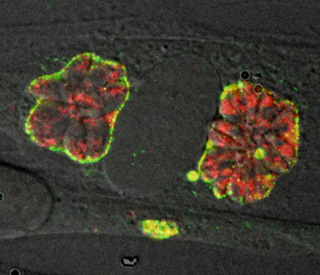
Human foreskin fibroblasts infected with Toxoplasma gondii tachyzoites and imaged by immunofluorescence against secreted parasite protein markers (Image courtesy of Daniel Gold, used with permission).
Instructor(s)
Dr. Ana Camejo
Dr. Daniel Gold
MIT Course Number
7.340
As Taught In
Spring 2013
Level
Undergraduate
Course Description
Course Description
Infectious diseases represent a serious global public health problem. They have the potential to kill millions of people, whether they emerge naturally as outbreaks or pandemics, or deliberately through bioterrorism. Some examples of diseases caused by emerging pathogens are the Bubonic Plague, Toxoplasmosis, African Sleeping Sickness, and Chagas Disease. Each day, infectious disease scientists serve on the front lines protecting us from such threats. In this course students will learn how to design and critique experiments through the discussion of primary research articles that explore the molecular basis of disease caused by emerging pathogens.
This course is one of many Advanced Undergraduate Seminars offered by the Biology Department at MIT. These seminars are tailored for students with an interest in using primary research literature to discuss and learn about current biological research in a highly interactive setting. Many instructors of the Advanced Undergraduate Seminars are postdoctoral scientists with a strong interest in teaching.


